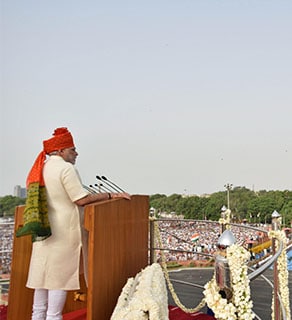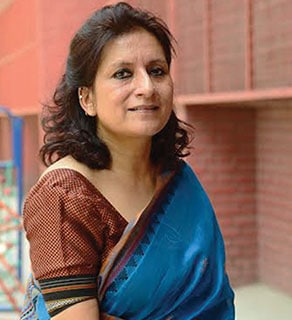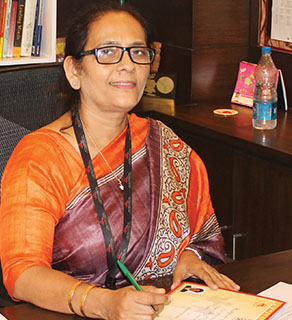
There are high hopes riding on India’s ambitious ‘Digital India’ programme. It is the government’s belief that this programme can potentially revolutionise education in India. India can ill-afford to ignore education anymore. A man with a humble background, Prime Minister Narendra Modi knows what ‘democratising basic needs and opportunity’ mean for a billion plus fellow Indians. However, there is a lot of ground that he needs to cover for this programme to turn into a digital revolution, writes K S Narayanan of ENN
Ashish Dhawan, CEO, Central Square Foundation
“The government must start with articulating a strategic and holistic vision for use of technology in advancing the school education reform and not just making our children digitally literate”
From kindergarten to higher education, a typical classroom in India has traditionally been about being crowded like a mini-auditorium, boring monologues by teachers and professors and students usually divided in their attention. Things, however, have slowly started to change now.
Contrary to pre-conceived notions of a land immersed in black magic, the great Indian rope trick and medievality, there is a new trend that is catching up fast in India. As digital technology permeates private schools and universities, both learning and teaching have become fun and easier. Educational institutions slowly begun embracing digital solutions for academics and campus management. This includes enrollment, attendance, teaching-learning process, managing curriculum and holding assessments and examinations. Many campuses have also started to slowly adopt hi-tech solutions.
Amid this wave of optimism that seems to have gripped India right since the announcement of this programme, one should not forget that there is considerable ground that needs to be covered. India has failed and has faltered on several grounds with regard to the Millennium Development Goals. As per Census 2011, India has managed a literacy rate of 74.04 per cent against 64.8 per cent in the previous census operations in 2001.
Anand Sudarshan Founder & Director, Sylvant Advisors Pvt Ltd
“I believe digital connectivity for each individual is equal to a fundamental right. The world is rapidly morphing into a connected world and, as a nation, we have the collective responsibility to respond to this change. Else, we will have added one more dimension – the digital connectivity dimension – to those who define the haves and have-nots”
This, however, does not imply that all of them have attended school or hold degrees. The Census document itself states that it is not necessary for a person to receive any formal education or pass any minimum education standard to be considered literate. According to an estimate, 4 per cent of India’s children never start school, about 58 per cent don’t complete primary education and 90 per cent don’t finish school.
R. Sreenivasan Chief Innovation Officer; Co-Founder, CL Educate
“I would want to call it ‘Connected Bharat, Enabled Bharat, Empowered Bharat’ rather than DIGITAL INDIA”
According to a UNESCO report, India needs 4 million teachers to keep children in classrooms. Those who do go to schools hardly gain much in terms of their learning outcomes.
This stark reality has been repeatedly pointed out to our Oxbridge policymakers who do not appear in sync with ground realities. The Annual Survey of Education Report (ASER) brought out by Pratham since 2005 has pointed out time and again that much of emerging India can’t read and do basic math and that going to school is not the same as learning. Similarly, in higher education, graduates passing out of enginneering colleges have not been found job-ready. Though policies have been scripted and funds allocated, the last 68 years of independence have failed to yield desired results.
Having stormed to power bringing to an end years of decision and administrative paralysis, the BJP government has set the tone for for a digital revolution in India – one that aims to impact the lives of 1.2 billion plus Indians. “‘Digital India’ is not an elite concept anymore. We have to use this idea to revolutionise health and education in India. Use broadband for education for rural areas, and telemedicine for the poor,” Prime Minister Narendra Modi said during his maiden Independence Day speech.
Despite being a cell phone nation, India is also home to the largest non-Internet user population in the world. According to US-based global management consulting firm McKinsey, an estimated 1.1 billion Indians remain offline, mostly in rural areas. The government’s digital push is aimed at bringing this population online. This is a major chunk of India’s populace that lives on less than $ 2 per day and it is this section that Modi aims to democratise basic needs for and provide opportunities that have been denied to them so far. “A digital India will enable us to compete with the world,” Modi asserts. The programme promises to transform India into a digitally empowered society and knowledge economy. Of course, both Modi and India badly need the programme to succeed as it has the potential to act as the means towards qualitative improvement of the delivery of basic services, accountablity and overall governance.
Pooja Goyal Founder Director, Intellitots, IntelliMinds
“Digital tools offer significant opportunity to bring education to every corner of the country. MOOCs are a good example of learning and breaking the barriers of classroom walls”
Unlike many populist and hyped flagship programmes in independent India, ‘Digital India’ is unique in many aspects. The focus is making technology central to enabling change. Digital India is an umbrella programme covering many departments with the common branding highlighting its transformative impact.
To transform education, Digital India offer plans to connect schools with broadband connectivity, free WiFi in all 2,50,000 schools and develop pilot Massive Online Open Courses (MOOCs). It also promises to provide WiFi in all universities and bring them all on the National Knowledge Network (NKN) and convert school books to e-books. To bring the rural youth into its fold, Digital India also proposes to train them for IT jobs.
In essence, the programme covers a wide range of areas that it seeks to develop under its ambit. What is heartening to see is that many of these ambitious plans also have stringent deadlines for delivery. However, there are doubts when it comes to the education sector. The reason being a conspicuous silence on the deadlines for delivery in the education sector. For instance, providing broadband connectity in schools or the digital literacy programme have no deadline.
While there may be lack of clarity on when these programmes fructify, there is one important area that has already been operationalised. This is the National Portal for Lost & Found children which has already been created. Although it is yet to be seen how successful we are in being able to track down thousands of missing children in the country who are forced into child-labour, prostitution, drug-peddalling etc., there is at least a beginning.
 Sundar Krishnan Director, American India Foundation
Sundar Krishnan Director, American India Foundation
“America India Foundation’s Digital Equaliser programme is a vision to provide oppportunities for underprivileged children in India and enhance their learning through technology. Through this Digital Equaliser programme, we are trying to bring in unity between the haves and have nots. My own pledge is to digitally unite 1.3 lakh schools in India”
Huge Market Potential
Pegged at an overall cost of `1,00,000 crore, Digital India involves high-speed Internet access and offering government services online. “The sheer opportunity that Digital India will create will also become a great business proposition,” Communications and Information Technology minister Ravi Shankar Prasad recently noted. According to one estimate, India’s online education market size is set to grow to $40 billion by 2017, up from the present size of $20 billion.
 Geethika Bahuguna GM, Quality Support Programme, Bharti Foundation
Geethika Bahuguna GM, Quality Support Programme, Bharti Foundation
“We are working with lot of government schools. We need to change the mindset of teachers to adopt digital technology though students are fascinated by it”
No wonder, digital czars from Sillicon Valley, such as Amazon. com chief executive officer Jeff Bezos, Microsoft Corp. chief executive officer Satya Nadella and Facebook Inc. co-founder Mark Zuckerberg have recently been seen making a beeline to visit India and meet with key government functionaries. This is being seen as a move that could only reboot their global profit enginees.
Needless to say, business opportunities to be unleashed by Digital India for those in the education sector would involve firms depending on the nature of their services or products. This would primarily include digital content providers, software technology providers and infrastructure companies.
 Sanyogita Sharma, Principal, Delhi-Surajkund Road, Faridabad Manav Rachna International School
Sanyogita Sharma, Principal, Delhi-Surajkund Road, Faridabad Manav Rachna International School
“The most important challenge for an educational institution (schools in particular) would be to guide the students on WHAT to see on the Internet rather than WHERE to see”
A key question is whether the Digital India programme allows big MNCs to exploit new opportunities here or will it create a class of new entrepreneurs as has been done in China? More importantly, can India uphold its digital soverieignity or is it happy playing the emerging market for the Big Boys of Sillicon Valley?
One of the long-term visions should involve building the infrastructure locally by Indians. For instance, India Post (India’s Postal Department) can provide citizens with digital cloud and e-mail facilities instead of asking them to sign up for Gmail or Yahoo services etc. Also, why not allow India’s homegrown software giants build these services?
 Ryan Pinto CEO, Ryan International Group of Institutions
Ryan Pinto CEO, Ryan International Group of Institutions
“We will ensure that through our schools, we will focus on digital pedagogies, professional development of teachers, suitable curriculum, classroom management techniques etc. to ensure that these become accretive to the education experience and add value to the students not only in cities but also in remote villages in India”
Challenges
Some of the key challenges include building data centres, managing security issues, safe and sound cyber laws and training government staff on protocols, data use and the legal ramifications of data breach. More importantly, for true success of the programme, the government will have to work on the basics. Mckinsey estimates that a total of 4 billion people in the world don’t have access to Internet – India accounts for 25 per cent of them. As India gears up for 4G, network coverage is poor in villages as most service providers don’t have the fiber lines covering those parts of the country, the report adds.
Dr Neeta Bali Principal, G D Goenka World School
“Digital India programme is a ground breaking initiative by the Prime Minister. We, as educators and facilitators, are learning a great deal from our students too who are digital natives while we are digital migrants. They are well ahead of us”
Till date, we have had no programme that has been conceived on this scale and magnitude, and the Modi government is aware of hurdles and bottlenecks in the Digital India implementation. To micromanage technical issues, the government has decided to appoint ten Chief Information Officers (CIOs) at key ministries to supervise the implementation. Besides, a Digital India Advisory Group (DIAG) would also be created, which will be headed by Minister of Communications and IT Ravi Shankar Prasad. Of course, the presence of the Prime Minister is an assurance that it does not end up as only hype or as a pipe dream like many schemes in the past.























